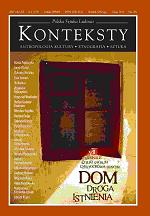Bezdomność jako droga tworzenia
Homelessness as the Path of Creation
Author(s): Renata Rogozińska Subject(s): Anthropology
Published by: Instytut Sztuki Polskiej Akademii Nauk
Keywords: anthropology; home
Summary/Abstract: The topos of sacrificing the home (conceived not as adwelling but as a'community of love') on the altar of art dates back to antiquity, although its strongest resonance took place in the nineteenth century. It is present in, i. a, the reflections of Nietzsche and Scho- penhauer, in which man’s greatness, symbolised by the saint and the genius, is closely connected with so- litude. Homelessness/solitude is, therefore, not only hopelessness and abandonment but also, according to Levinas, courage, pride and sovereignty. It assists the artist in attaining inner autonomy, sets free the power to understand, and favours raising oneself above hu- man measure. Only (absolute!) solitude reveals that which is most important: it is the condition for disco- vering the truth. The shape of atower assumed by the studios of Hu- bert von Herkomer or Carl Gustav Jung, ostentatio- usly inaccessible to others, should be recognised as aspectacular manifestation of the artist’s inner exile. The category of homelessness is also associated with atrain station waiting room, which for Simone Weil comprised a sui generis niche for reflection, or the ho- tel room, in which Albert Camus wrote. It is by no means an accident that the formal and ideological model for images of the atelier, universal in painting, was the depiction of St. Jerome or St. Augustine in their workshops. After all, they comprise arepresen- tation of the supreme form of afree and beautiful life – bios theoretical, or the Latin vita contemplative – ali- fe consisting of contemplating that which is beautiful because it is invariable, eternal and divine, and thus of studying the truth and philosophising. The exhibi- tion entitled 'The home – the path of being' shows that solitude, alienation and escapism are still part of quite afew programmes of the artist’s studio, with considerable space taken up by paintings featuring the motif of the atelier. The Vast Studio by Jerzy Mierze- jewski, suffused with light and silence, seems to indi- cate the supernatural source of creative inspiration. Only such conditions can give rise to avision and then witness the miracle of its embodiment into awork. After all, it was believed that the creative act consists of atranscendence, atransition from the sphere of the profanum to that of the sacrum, an opi- nion of adifferent perspective, achange in the man- ner of perception. This is agreat mystery. Although today such an approach is rare, upon certain occa- sions the studio is still treated as an exceptional and magical site, marked with sanctity. 'We lived in aho- use that resembled aBuddhist or Hindu monastery' – the painter Jerzy Ćwiertnia recently spoke about the home-studio shared with his daughter, also apainter. 'When Nowosielski came to visit' – recalled Jerzy Tchórzewski – 'I received him in the flat. At acerta- in moment Jurek said: <<It’s very pleasant here, but let’s move to the studio. You know, there is
Journal: Konteksty
- Issue Year: 2010
- Issue No: 02-03
- Page Range: 190-194
- Page Count: 5
- Language: Polish
- Content File-PDF

